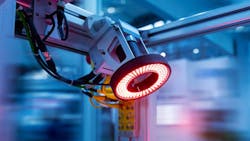Industrial IoT Platform Brings AI to the Factory Floor
Telit Cinterion introduced an industrial-grade software platform that helps manufacturers connect machines, gather data from devices on the factory floor, and feed it all into AI systems without needing to write complex code.
According to Telit Cinterion, the deviceWISE AI platform is built to bridge the gap between operations and IT systems. It can translate the data from robotics and other machinery into valuable insights in real-time, enabling companies to detect issues early on and take action before problems escalate. That helps minimize downtime and reduce the risks to production. For design engineers, it gives them a flexible platform for industrial automation that can be used in environments from prototyping to full deployment.
The industrial Internet of Things (IoT) solution works with a wide range of machines, sensors, and software systems, facilitating integration into any manufacturing environment.
One of the highlights of the solution is its data orchestration. It can connect to many different types of industrial equipment and automatically collect and manage data. Engineers and technicians are able to create visual workflows that tell the system what data to collect, where to send it, and what actions to take.
These workflows are created using a drag-and-drop interface, taking the complexity out of adding automation to a factory floor, said Telit Cinterion. For instance, deviceWISE AI can be configured to monitor a machine’s temperature and then automatically send alerts or shut it down if it overheats.
Telit Cinterion partnered with NVIDIA to integrate AI features into the latest version of deviceWise AI. This means manufacturers can run advanced AI models on the factory floor without sending the data to the cloud first.
By processing data directly at the edge, these models perform real-time tasks such as identifying visual defects, predicting equipment failures, and interpreting handwritten maintenance logs using natural language processing. Engineers can use pre-trained NVIDIA models or develop their own.
The new capabilities run on top of several different AI frameworks, including:
- Retrieval-Augmented Generation (RAG): Enables users to interact with complex industrial systems utilizing natural language to obtain real-time insights. For instance, engineers can get access to performance metrics for different machines, production status, and training documentation through conversational text or speech inputs.
- Visual Language Models (VLMs): By combining computer vision with natural language processing, VLMs enable systems to interpret visual data—including images, video feeds, and operational dashboards. That way, the system can identify anomalies, monitor the status of different machines, and run quality-control processes, reducing the need for manual inspections.
- Video Search and Summarization: This feature leverages machine learning to analyze and summarize events in video streams. As a result, deviceWISE can identify critical incidents, monitor production lines without requiring users to watch hours of video. It also allows users to search within video archives.
- Personal Assistance Interfaces: These tools enhance interaction with industrial systems by incorporating voice and text command functionality with real-time feedback. By simplifying access to system controls and data, they can help improve human-machine interaction and decision-making on the factory floor.
Importantly, the deviceWISE AI software also connects equipment and data on the factory floor to larger IT systems and cloud platforms such as Amazon AWS, Microsoft Azure, and Google Cloud. This enables companies to modernize their operations without ripping out existing infrastructure.
The industrial-grade software is engineered to be secure. It supports encrypted communication, including Transport Layer Security (TLS 1.3), which helps protect sensitive data as it travels between devices, systems, and the cloud. The TLS 1.3 standard reduces the risk of digital attacks by removing older, less secure encryption methods and speeding up the process to establish a secure connection. In addition, the platform features robust device authentication and user access controls, according to Telit Cinterion.
By integrating industrial connectivity, real-time data management, cloud integration, and AI into a single solution, Telit Cinterion said the system is all about bringing more intelligence to the edge—whether to a single machine or to a full-scale production line.
About the Author
James Morra
Senior Editor
James Morra is the senior editor for Electronic Design, covering the semiconductor industry and new technology trends, with a focus on power electronics and power management. He also reports on the business behind electrical engineering, including the electronics supply chain. He joined Electronic Design in 2015 and is based in Chicago, Illinois.

